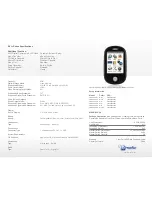
22
Tascam MMP-16 User’s Guide • Chapter 2 • Installation
MMP-16
Audio Connections
All audio outputs (both analog and digital) of the MMP-16 use DB-25 connectors. The pin configuration
used on the DB-25 analog audio connectors is identical to that used for Tascam DTRS format digital tape
machines such as the DA-88. Two female DB-25 connectors are used for the analog connections, one for
channel 1-8 and the other for channels 9-16, as labeled on the MMP back panel. Each of the digital
outputs uses a female DB-25 connector to carry eight channels of AES/EBU digital output signals (two
sets of four stereo pairs). These are labeled as digital outputs 1-8 and 9-16.
Analog Output Connections
All analog outputs use balanced signals designed to mate with standard 600-ohm devices using +4 dBu
levels. Analog audio processing is done on two separate 20-bit Digital to Analog converter cards mounted
within the MMP-16. These converters are mounted in a special shielded cage within the MMP and are
attached via ribbon cable to a card (labeled AO) plugged into one of the system ISA bus slots on the PC
motherboard. These D/A boards have their own power supply separate from the main PC power supply.
Max load is 12.28 VRMS.
Digital Output Connections
Two female DB-25 connectors are used to provide four stereo digital outputs each, for a total of sixteen
channels of digital audio output. Two Tascam DA-88 analog I/O cables should be used as digital output
cables. Even though the MMP-16 has no audio inputs, the digital input 1&2 pair on the first digital input
cable is the default reference input for the AES/EBU clock reference. This can be changed to use digital
input 3, 5, or 7 from one of the other three digital input pairs using Setup Menu 600 (Dig In Ref Track).
NOTE: The digital clock signals coming from any external device connected to the AES/EBU inputs will
force the MMP-16’s internal clock to try to lock to it when digital input is selected (Setup Menu 500).
This can cause playback problems if the clock source is not accurate. If this occurs set that track to use the
sample rate converter in Setup Menu 500 (Input Source).
Monitoring Connections
For monitoring at the MMP-16 there is a mono headphone jack on the front panel (compatible with stereo
headphones of either low or high impedance). For studio Cue or remote monitoring there is a rear panel
line level mono mini phone jack. It is an unbalanced output designed to be connected to external
amplification.
The front panel headphone monitor jack is controlled by the LEVEL control located next to the jack on
the front panel. Press the MON key and select the desired tracks using the Track Select keys to choose
which of the MMP-16 tracks will be summed to appear at the headphone jack output. The rear panel jack
is a pre-LEVEL control, so it is a fixed line level output (-10 dBu), and it always presents a summed
output of the audio channels selected using the MON function on the front panel.
Summary of Contents for MMP-16
Page 1: ...MMP 16 Modular Multitrack Player D00000000A OWNER S MANUAL...
Page 5: ......
Page 6: ......
Page 7: ......
Page 8: ......
Page 9: ......
Page 41: ...36...
Page 73: ...Tascam MMP 16 Owner s Manual Chapter 5 MMP 16 System ApplicationsMMP 16 68...
Page 93: ...Tascam MMP 16 Owner s Manual Appendix A Control Panel Summary 88...
Page 95: ...Tascam MMP 16 Owner s Manual Appendix A Control Panel Summary 90...
Page 119: ...Tascam MMP 16 Owner s Manual Index 114...
















































